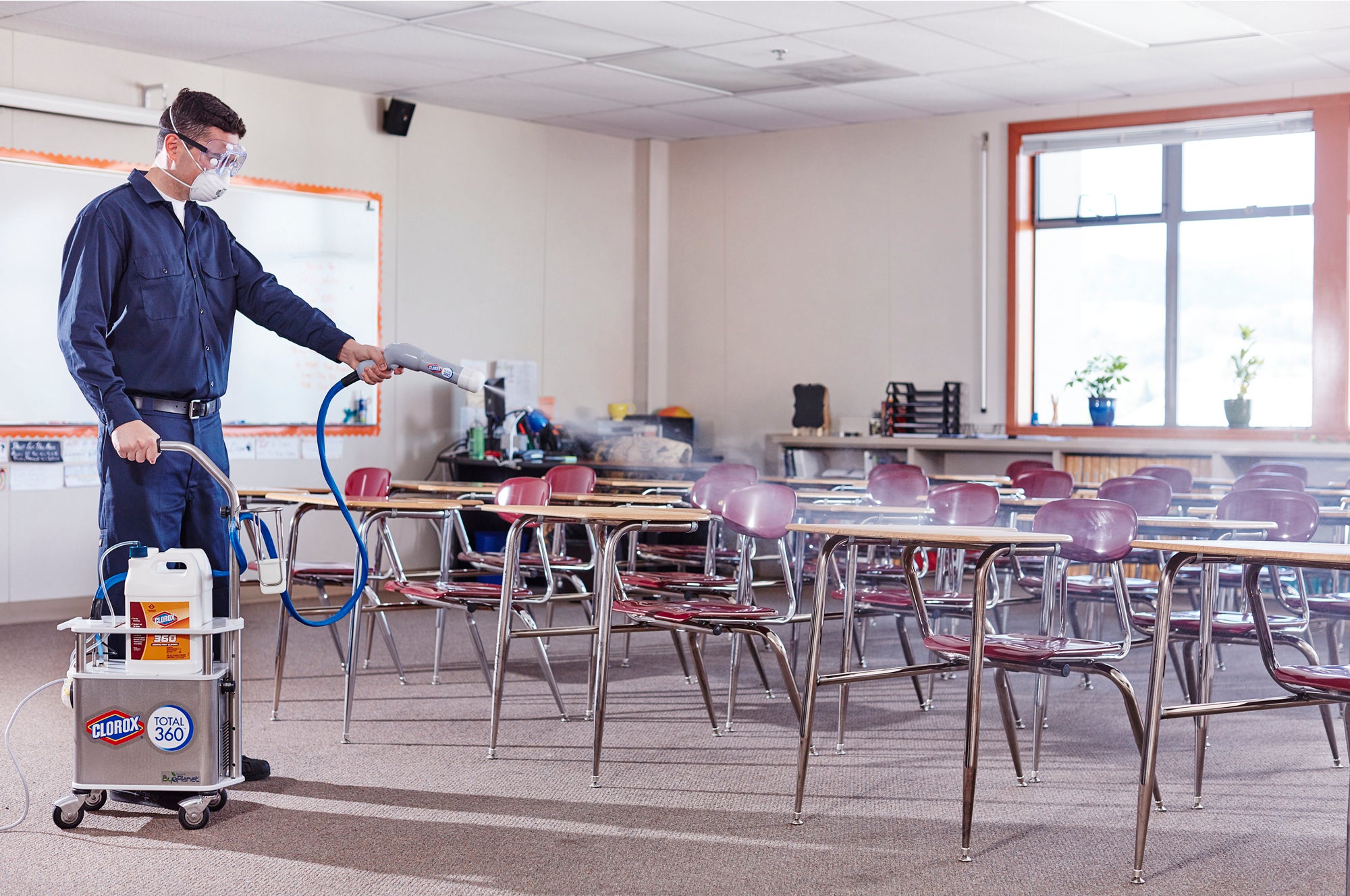CloroxPro Blog – Professional Cleaning and Disinfection Insights
A blog from industry experts devoted to public health awareness, best practices, and the role of environmental cleaning and disinfection, to promote safer, healthier public spaces.
Back to School, the “New Normal” https://www.cloroxpro.ca/blog/the-new-normal/ July 27, 2020 August 18, 2020 https://www.cloroxpro.ca/wp-content/uploads/2020/07/NI-42438_PPD_CLX_ZuulDevice_HS_Classroom_036_1016_i2_19-03-18-1258_high-res.jpgBack to School, the “New Normal”
As Canadian provinces begin to ease lockdown restrictions resulting from the severity of the COVID-19 pandemic, there seems to be an inevitable shift towards a “new normal” for not only the public, but also for private and public establishments.
Conventional cleaning and disinfection generally involves manually applying cleaning and disinfection solutions and wiping with cloths.1 This method has variable effectiveness and spray-and-wipe cleaning and disinfection procedures in healthcare settings frequently do not achieve consistent desired results.2
We can do better
The electrostatic application of disinfectants is a newer technology, which when used together with conventional cleaning can significantly boost levels of disinfection.3
The electrostatic sprayer sends a negatively charged cloud of disinfectant that envelopes sprayed objects and the charged particles are attracted to surfaces leading to more uniform disinfectant coverage. The electrostatic dispersed disinfectant spray can also reach hard-to-reach locations where pathogens may be beyond the reach of manual spray bottle and wiping procedures.3
Practical use of new disinfection technology
A Canadian study, published in the Canadian Journal Infection Control, conducted in several schools ranging from Kindergarten to High school, assessed the effectiveness of conventional cleaning and disinfection compared with the addition of electrostatic spray disinfection technology (Clorox Total T360®) to conventional cleaning and disinfection on the general hygiene state of student desks.4

The viable microbial loads on 100 student desks were assessed via Replicate Organism Detection and Counting (RODAC) plates before and after cleaning and disinfection procedures.
Desks were sampled at the end of the school day before cleaning and disinfection interventions. After cleaning and disinfection interventions were conducted, RODAC sampling took place after approximately 30 minutes in order to allow the desks to dry completely. Sampling was conducted on the lower middle portion of desktops where students have the most contact with the desk.
In all schools, cleaning and disinfecting was conducted in their usual manner. Schools used spray bottles and cloths or solution, bucket, and cloth with hydrogen peroxide or quaternary ammonium solutions. Electrostatic spray disinfection technology consisted of an electrostatic sprayer and quaternary ammonium disinfectant solution containers mounted on a portable cart.
The results demonstrated an additive effect in significantly reducing pathogen colonies on the student desks (N=36)4:
- Mean pretest colony-forming units (CFUs) per desk were 126.8.
- Following conventional cleaning and disinfection, mean CFUs decreased to 73.4 (P = 0.0003), representing a significant 42% reduction in mean CFUs.
- Use of subsequent electrostatic disinfectant spraying after conventional cleaning and disinfection further reduced mean CFUs to 54.2 (P = 0.02), representing a significant 57% reduction in mean CFUs.
The independent effect of electrostatic disinfectant spraying without an intervening conventional cleaning step was also tested on 64 desks. Mean pretest CFUs were 106.4 and after electrostatic disinfectant spraying mean CFUs decreased to 62.9 (P = 0.001), representing a 41% significant reduction in mean CFUs.
Conventional cleaning and disinfection procedures were effective in reducing viable microbes on student desktops. However, there was a significant additive disinfection effect when electrostatic spray disinfection followed conventional cleaning and disinfection.
Schools – Plan to prevent
The Ministry of Education in Ontario has recently issued recommendations for cleaning and disinfection of schools and student transportation to prevent the spread of COVID-19 in preparation for the 2020-2021 school year5:
- Develop additional cleaning protocols including the required cleaning equipment, surfaces to be cleaned, and frequency.
- Cleaning and disinfecting high-touch touched surfaces and shared resources such as doorknobs, water fountain knobs, light switches, toilet and faucet handles, electronic devices, students’ chairs and desks/tabletops at least twice a day, as they are most likely to become contaminated.
- For transportation, frequently touched surfaces (e.g., handrails, seats, seat belts, floors, windows, steering wheel) should be cleaned and disinfected at least twice per day.
- Only use approved hard-surface disinfectants that have a Health Canada approved Drug Identification Number (DIN).
Manufacturers such as Clorox, makers of disinfectants that are approved for use against SARS-CoV-2, the virus that causes COVID-19, can play an important role in educating and working with school authorities to assist with setting up cleaning and disinfection protocols that are in line with public health guidelines.
Invest to prevent
The Ministry of Education in Ontario has announced net new funding for cleaning, cleaning protocols, and financial support to hire additional custodial staff in September 2020, to ensure schools are safe.6
Heightened scrutiny for infection prevention and control in the post COVID-19 pandemic era will ensure requirements for more stringent and improved infection prevention and control measures are put in place.
It may be prudent to invest in proper cleaning and disinfection procedures and equipment, such as electrostatic spray disinfection technology. The cost of prevention may be lower than the cost of treatment.
References:
- Bright KR, et al. Occurrence of bacteria and viruses on elementary classroom surfaces and the potential role of classroom hygiene in the spread of infectious diseases. J School Nursing 2009;26:33-41.
- Sattar SA. Promises and pitfalls of recent advances in chemical means of preventing the spread of nosocomial infections by environmental surfaces. Am J Infect Control 2010;38:S34-40.
- Clorox Total 360® System and Solutions. https://www.cloroxpro.ca/products/clorox/total-360/. Accessed August 13, 2020.
- Douglas Forb, B & Sopha K. An evaluation of conventional cleaning and disinfection and electrostatic disinfectant spraying in K-12 schools. Can J Infect Control 2020;35:35-38.
- Approach to reopening schools for the 2020-2021 school year. https://www.ontario.ca/page/approach-reopening-schools-2020-2021-school-year#section-5. Accessed July 3, 2020.
- Letters to Ontario’s parents from the Minister of Education. June 19, 2020. https://www.ontario.ca/page/letter-ontarios-parents-minister-education. Accessed July 3, 2020.
